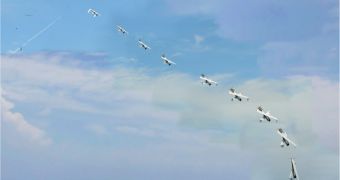Engineers with the US Naval Research Laboratory (NRL) recently demonstrated the first drone that can be launched from the missile tubes of submerged submarines. The eXperimental Fuel Cell Unmanned Aerial System (XFC UAS) may be used by the US Navy for diverse missions in the near future.
This particular UAS is all electric and powered by fuel cells. During the recent test, XFC launched from an empty Tomahawk bay aboard the Los Angeles-class nuclear submarine USS Providence (SSN 719). The Sea Robin launch vehicle system was used to support the launch, the NRL announces.
The new drone was developed with support from the Office of Naval Research, through its SwampWorks program, and the US Department of Defense, through its Rapid Reaction Technology Office. It only took 6 years for this drone concept to make it from the drawing board to prototype tests.
“This six-year effort represents the best in collaboration of a Navy laboratory and industry to produce a technology that meets the needs of the special operations community,” says Dr. Warren Schultz, who is the developer and manager of the new drone program at NRL.
Research and development efforts for other drones can take decades to complete, which is why this short time frame is so impressive. “Developing disruptive technologies and quickly getting them into the hands of our sailors is what our SwampWorks program is all about,” comments the acting director of innovation at the ONR, Craig A. Hughes.
The real goal behind developing the XFC is to provide the US Navy submarine force with the ability to collect mission-critical intelligence, surveillance and reconnaissance (ISR) data in real-time, and without the need for the ships to resurface.
The new drone can be deployed as the submarine is submerged, and then lifts to the surface like a cork. Once it pops up like a buoy, two small booster rockets fire up and take it out of the water. During the recent test, the vehicle flew for a few hours before landing.
Once it finishes its mission, the drone uses a parachute to make a soft water landing. A small guidance robot is then released from the submarine, carrying a cable that attaches to another cable dropped by the probe. When the connection is secured, the submarine reels the probe down into its missile bay.
“The creativity and resourcefulness brought to this project by a unique team of scientists and engineers represents an unprecedented paradigm shift in UAV propulsion and launch systems,” Schultz concludes.

 14 DAY TRIAL //
14 DAY TRIAL //